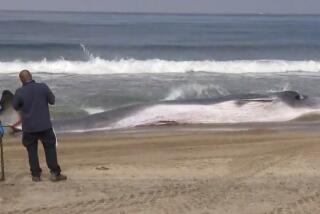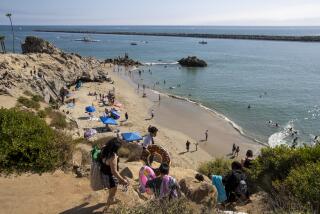Volunteers Hit the Beaches for Dolphin Count
The surfers bobbing nearby were oblivious, along with most of the joggers and skaters skittering down the bike path along Bolsa Chica State Beach.
But Lucia Thompkins, binoculars to her face and dolphin-safe tuna sandwich by her side, caught the entire show Saturday morning.
A solitary slate-gray fin gracefully arching out of the ocean, with others churning up right behind.
Within minutes, the water in front of her was alive with fins, tails and airborne bottlenose dolphins. A mammoth pod of 20 adults was making its way up the coast, and enjoying itself along the way.
“This is my favorite spot, and now you know why,” said Thompkins, a school administrator from Westminster who has been a dolphin watcher for 10 years.
Thompkins joined a dozen other volunteers who fanned out along Orange County’s coast Saturday to conduct a one-day census of the area’s bottlenose dolphin population.
The dolphin watchers, posted on piers, bluffs and sand dunes from Dana Point to Bolsa Chica, spotted at least 40 during the day. Along with those that made their way past Thompkins, 20 more were seen north of Laguna Beach in the waters off Crescent Bay Point Park.
“Essentially, it lets us know whether the species is thriving or dying,” said Bert Vogler of the local chapter of the American Cetacean Society, which organizes the quarterly count. “We don’t know much about the population of bottlenose dolphins in Orange County and we’re trying to learn more.”
The dolphin count has been conducted since 1987 and at times has attracted as many as 200 volunteers. But unlike the area’s steady dolphin population, volunteers have been dwindling in recent years. Vogler blamed the decline on a lack of publicity and the increasing competition for people’s time on weekends.
The event was the brainchild of Orange Coast College marine biologist Dennis Kelly, who was curious about the size and range of Southern California’s dolphin population, and fearful about what he saw as an increasing threat from the pollution and destruction of the dolphin’s fragile habitat.
Kelly no longer takes part in the count, but said the quarterly census and his own research shows that nearly 800 coastal bottlenose dolphins occupy the waters between La Jolla and Monterey, a number that has been relatively constant for the last decade.
In the event of an oil spill or other disaster causing a mass die-off, keeping tabs on the dolphins may prove to be a valuable tool, he said. Scientists will know how many dolphins existed, and can then determine when, or if, the ocean mammal has rebounded, Kelly said.
That wasn’t the case on the East Coast in 1987, when hundreds of bottlenose dolphins washed ashore from New Jersey to Florida. Years passed before experts learned a previously undiscovered distemper virus was at fault, but they never had a solid estimate of the East Coast dolphin population before the deaths.
Still, while the count provides a rough snapshot of how the region’s dolphins are faring, the data collected have only nominal scientific value, since the people counting are not trained researchers and the method is not exact.
But that doesn’t worry Kelly, who said the event has more to do with public enlightenment than providing data for oceanographers.
And it worked.
“Within a year or two after we started, whenever a development was proposed along the coast, there were people asking about the effects on the dolphins,” said Kelly, who has aggressively challenged several coastal developments. “We want everybody to realize there are dolphins out there.”
Tami McFadden and her friend Sue Fowler will have to take his word for it.
The two nurses from Huntington Beach spent Saturday morning peering over the waves at the mouth of the Santa Ana River in Newport Beach, and only spotted surfers, pelicans and a tire bobbing out beyond the breakers.
“They’re cute, and entertaining--if you see them,” Fowler said.
Fowler and McFadden didn’t complain much, though. Underneath a thin gauze of clouds stretched across the sunny sky, Fowler and McFadden lazed in their beach chairs sipping coffee and munching on cottage cheese and pears.
“It’s not a bad way to spend the morning,” Fowler said.
Anyone interested in volunteering for the next scheduled sighting day in April can call the American Cetacean Society at (714) 534-5177.



